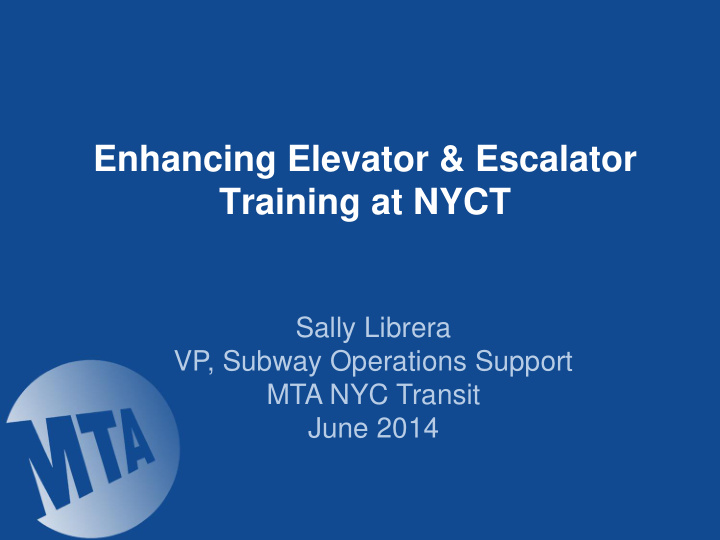



Enhancing Elevator & Escalator Training at NYCT Sally Librera VP, Subway Operations Support MTA NYC Transit June 2014
Elevators & Escalators at NYCT: 2014 Facts and Figures • 355 employees • $51M operating budget • Elevator Equipment – 39 Traction Elevators Escalator availability 1 : 95.5% – 216 Hydraulic Elevators Elevator availability 1 : 96.7% – Manufacturers: OTIS, Motion Control Engineering, Automation Controls & Communications Technology, Elevator Availability > Goal Systems Inc. 10 straight quarters • Escalator Equipment – 181 Escalators – Manufacturers: Shindler, Kone, Fujitec, O & K 1 – 2014 quarter 1 availability. Availability measures the percent of time that a unit is running and available for customer service; includes all outages 1 except capital replacement.
Elevators & Escalators at NYCT Elevators and Escalators is a Subdivision with Maintenance of Way at NYCT Maintenance of Way Subways Track Infrastructure Elevators & Escalators Electrical Positions - 2,732 Positions - 1,473 Positions - 355 Positions - 2,018 Engineering Electronics Maintenance MOW Operations Center Positions - 326 Positions - 1,468 Positions - 36 2
2008 3
NY Giants – Superbowl Champions 4 Images: NY Times, Wordpress.com
Brooklyn Bridge turned 125 Image: NY Daily News 5
NY Yankees played final game in Yankee Stadium Yankees 7, Orioles 3 Image: NY Daily News 6
Challenges at NYCT: 2008 Snapshot High Need for E&E Skill Development • High vacancies for Elevator & Escalator maintainers • Rigorous technical requirements – employees expected to maintain Elevators and Escalators • Transit wages lower than private industry – not poised to attract highly skilled workforce • Apprentices hired on for E&E positions with basic electrical training, no experience • 1 in 6 elevators & escalators were out of service for over a month during the previous year Formalized Skill Development Programs Lacking • A single 3-week course which focused on safety, procedures and rules & regulations • 1 E&E instructor responsible for training and course development **Need for enhanced E&E Training programs 7
2008 Snapshot: Apprentice Program Labor Source & Qualifications: • Vocational HS Graduates • Incumbent employees, upon completing 6 months of commercial technical training Apprentice program lacked strong curriculum and E&E Apprentice Program: structure to support • Formalized training classes same as E&E inexperienced maintainers maintainer • On the job rotations Program Length:3 years Success Rate: Marginal 8
Step 1: Intensified In-house E&E Courseware Development In-house efforts: • Added instructor resources focused on growing programs and developing curriculum • Developed NYCT-specific courses focusing on technical skill development, and NYCT procedures • Expanded use of NYCT Escalator Learning Annex Recognized Need for External Curriculum Development Resources 9
We were not alone 10
Step 2: E&E Training Consortium • Objectives: Develop comprehensive training for Elevator & Escalator maintainers • Drivers: • High need • Costs of development could be shared among properties • Transportation Learning Center facilitated • FTA match • Labor-management partnership • Agencies shared: • Resources • Subject matter expertise • Existing training materials 11
E&E Training Consortium: Curriculum Development Approach Third Party Curriculum Developers & Technical Publishers Subject Matter Experts from Properties Training Standards Previously Developed by E&E Tech Forum 12
Consortium Deliverables • 100 series provides basic electromechanical skills: Introductory and Basic Courses Examples: – Electrical Fundamentals – Tools and Material Handling – Mechanical Theory and Application • 200 series covers elevator and escalator equipment skills . Courses for employees with electromechanical background and limited E&E experience Examples: – Handrail Installation and Maintenance – Step Installation and Maintenance – Elevator Mechanical Drive System • 300 series for advanced E&E equipment maintenance are designed for skilled workers. Examples: – Input Output Control Equipment – Electrical Electronic Systems – Advanced Electrical Printreading 13
NYCT E&E Training Today • Actively offering 11 courses at introductory and intermediate level • New employee training: 504 training hours, phased within year 1 • Induction training includes 3 courses from Consortium program Step Installation & Maintenance Handrail Installation & Maintenance Hydraulic Elevators • Developed 8 courses specifically tailored to the maintenance environment of NYCT • In 2013, Elevator & Escalator training delivered to 161 participants, totaling 3,052 training hours 14
Next Steps – Transition to Training Track model 2014 • Add 3 Consortium courses to active course rotation • Escalator Electrical Systems • Elevator Electrical Systems • Principles of Troubleshooting • Expand new hire training to 16 courses • 3 Consortium courses added in 2014 + 2 NYCT-developed courses • Curriculum Tracks 2015 • Assessment process for E&E maintainers to identify level of technical skills • Courses grouped into training tracks corresponding with level of technical skills • Apprentice Program: Integrate Consortium materials and structure OJT to formalize existing Apprenticeship Program 15
Recommend
More recommend